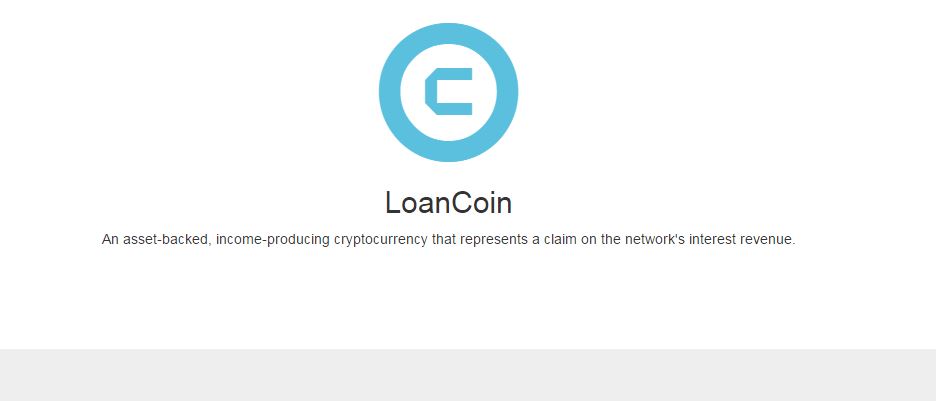
LoanCoin is the first fully on-blockchain lending network project using a crypto currency, working has an “equity” which represents the holder investment. LoanCoin, introduces the decentralized banking of the future.
LoanCoin is set to be polymorphic digital token. It will serve as an in-network currency that will be used to pay transaction fees to loan officers and as a surety bond to ensure loan officer honesty. From the coinholders perspective, it will be an asset-backed, income-producing store of value similar to a high yielding savings account. The team expects LoanCoin to be fairly stable relative to other cryptocurrencies, with the value of the network’s outstanding loans providing a valuation floor, and LoanCoin to appreciate via the reinvestment of interest and principal repayments.
From the coinholders perspective, it will be an asset-backed, income-producing store of value similar to a high yielding savings account. The team expects LoanCoin to be fairly stable relative to other cryptocurrencies, with the value of the network’s outstanding loans providing a valuation floor, and LoanCoin to appreciate via the reinvestment of interest and principal repayments.
The team’s mission is to make LoanCoin decentralized and trustless but, for the time being, it’s running a centralized version on top of Counterparty.
On the existing peer-to-peer lending platforms, such as LendingClub and Prosper, the demand for loans outstrips the supply of borrowers. Additionally, secondary trading in these loans is highly illiquid and selling a note prior to maturity will result in a significant loss. Most of the existing cryptocurrencies are volatile supply-demand currencies that are highly susceptible to speculative price swings. Lending DApp aims to expand the supply of borrowers and provide a more liquid secondary market via LoanCoin, the value of which tracks the value of the underlying loan portfolio.
This Loancoin network will be based and regulated over a system of trust; the amount of trust will be accorded to a loan officer specified by the network.
Trust lines are meant to specify the amount of collateral a loan officer must post in LoanCoin when extending credit to borrowers. The more reputable a loan officer, the lower its required surety bonds and the higher its credit line. 
Each loan officer’s aggregate trust line is determined by coinholder consensus. That is, every coinholder can extend trust ratings to as many loan officers as they wish. A particular loan officer’s trust line is computed by applying an aggregate function to its set of weighted trust ratings. Thus, the network draws on the collective knowledge of its participants in assessing a loan officer’s reputation and creditworthiness. The idea of trust lines is somewhat inspired by Ripple trust limits12 and Bitcoin Web of Trust.
The Loancoin network Protocol
1. Investors mine new LoanCoin by investing fresh outside capital into the network. This capital goes into the pool used to make loans.
2. Coinholders extend trust lines to loan officers. Assigning high trust lines to trustworthy, high-performing loan officers and punishing untrustworthy or poorly-performing ones will increase returns across the network.
3. Loan officers select borrowers, make loans, and enforce repayments. Depending on their trust rating, loan officers may be required to post a surety bond using LoanCoin. This effectively secures loans from the network’s perspective and aligns coinholder and loan officer incentives, discouraging abuse or fraudulent activity. The credit line of each loan officer also varies depending on the aggregate trust line accorded to them by the network. The network uses a value network bridge with a decentralized currency exchange (such as Ripple or Stellar), to make currency-agnostic loans.
4. Loan officers charge origination or performance fees, the latter of which is determined by the difference between the risk-adjusted performance of the loans selected by the loan officer and the average risk-adjusted loan performance of all loans in the network. We expect competition between loan officers to drive down costs.
5. Borrowers repay interest and principal on their loans either directly to the network or through their loan officer. As repayments are made, loan officers may reclaim a proportional amount of their surety bond. In the event of a default or missed payment, the loan officer forfeits its surety bond, making the network as close to whole as possible.
6. When repayments are passed back into the network, coinholders may elect to reinvest the proceeds back into the network to mine new LoanCoin. Alternatively, they may take payment directly, via BTC or other supported currencies. In the latter case, a proportional amount of their LoanCoin is destroyed.
The network is effectively making loans to the loan officers, not the end borrowers.
We can think of Lending DApp as the super node and each loan officer as a child node Child nodes can lend directly to borrowers or behave in a similar manner as the super node, establishing their own network of trusted loan officers and even issuing their own child coin. 
The network can be thought of as a fund of funds. Investors can purchase LoanCoin for exposure to the entire network or, if they prefer more specific asset exposures, they can purchase child coins from a child node that specialized in certain kinds of investments (emerging market debt, T-bills, corporate debentures, etc.).
The LoanCoin project appears to have all what it takes to succeed. The team has really introduced some innovative concepts into the crypto loan investment industry;
LoanCoins are backed by loans made by the network and appreciate via the reinvestment of interest and principal payments. This yields a stable crypto currency with all the benefits of bitcoin – ease of transfer, low transaction fees, security, and privacy – but with much less volatility. It is really trying to offer what many are looking for: a stable crypto currency.
Link to source: 1, 2
Photo source


















